|
Snowstorm, flooding, freezing! We've had some wild weather lately. It can be hard for us humans to negotiate the snowy roads, the flooded roads, the icy roads, but think of the fish! We enjoy the protection of our steel vehicles and then get to retreat to our heated, winterized homes. We're most fortunate. The stream-residing trout of Vermont, however, have no such protections. Ask your students to imagine what the trout might have been doing on a day like last Thursday, when many rivers looked something like this. And what do the trout do when the rivers freeze up? What are their options when, as sometimes happens, the river ice goes all the way to the bottom? Great videos from our teachers Nathaniel Moore, at South Burlington High School, shared this fabulous video of, as he calls it, a "conjoined trout." Thanks so much for recording the footage, Nathaniel, and, especially, for annotating it. Jen Grilly, of the Bridge School, sent me this video of one lone unhatched egg amidst numerous active alevin. Here's how Jen described the situation: Life is so hard when you are trying to hatch and your sibling rams into you! Reading the ammonia test strip This past Monday, Lisa Marks, of Ludlow Elementary School, sent this question: When you read the ammonia strip do you read the yellow side or the white side? Because I haven't used the API test strip system much since we switched away from the solution-based water test kit, I needed help answering that question, so I contacted the API company. Very quickly, API Consumer Relations Technician "Taylor K." responded with this: You should use the yellow side. That side has the regent on it to react with water. This is important. Reading the wrong side could give you incorrect information that might be way off the actual ammonia level. Macro presentation Paul Urband and Doug Zehner will be giving a presentation on macroinvertebrates to students at Shoreham Elementary School on February 6. Doug put together a very nice PowerPoint slideshow called "What will our trout eat?" for this purpose, and he and Paul invited me to share it with you. Because the file is rather large, I put it in the Google Docs folder. Click on the opening slide below or on the title above to go straight to the folder that contains the full presentation. DI and hatching I'm still eager to collect as much information as you can send me about what the DI was when your eggs hatched. Here are four teachers' reports:
P.S.: I'll be even more interested in getting analogous data for when, that is, at what Cumulative DI level, your fish "swim up." So keep tracking those numbers.
0 Comments
Video of two-headed alevin. Resources for TIC curricula. More about mold. Store that frozen water!!1/23/2019 Steve Flint's video In our last blog I shared a photo of a two-headed embryo. In response, Steve Flint, of Mary Hogan School, sent me a short video of a two-headed alevin that hatched in his TIC tank two years ago. Enjoy! Getting new ideas for TIC curricula Two weeks ago a 3rd grade teacher in Virginia submitted a question to our TIC/SIC national e-mail group. Amy Lenz wrote, "I would love to hear how other teachers are making this program even more academically rigorous." Two state coordinators were among those who responded, and each gave us all access to two resources I hadn't previously known about. Judy Tumosa, watershed education specialist and TIC coordinator for NH Fish and Game, sent Amy a copy of the NH TIC Activity Guide. Tracy Page, aquatic education coordinator for Michigan's Department of Natural Resources, sent Amy Michigan's Classroom Activity Guide for schools raising salmon. Both of these activity guides provide numerous terrific and interesting ways in which you can extend the TIC program in your classroom. Check them out! While we're on the subject, I should remind you of the two documents that connect TIC activities with the Common Core State Standards and the Next Generation Science Standards. Both of these are in the Google Docs collection on this Web site, but I've also linked them to those underlined phrases above. And finally, don't overlook the curriculum resources that Trout Unlimited's national TIC coordinator maintains. As you can see, the resources are organized by curricular area. Click here or on the image above to go directly to the TUTIC Web site. More on mold Jeff Walker, of Benson Village School, sent me this photo this morning and asked, "Is that mold?" I said I thought it probably was and suggested that Jeff use his baster to remove the mold. Jeff replied that he had tried that, "But the baster didn't really do much. I think I'll have to transfer the eggs to another container and remove it then." Then he reported: Thanks for your help with the mold! I transferred the eggs to a beaker while I cleaned the basket and took this pic. When I got the mold out, I found that a decayed egg and a fry were caught up in the seam of the basket. Here's a photo of his now mold-free eggs and alevin. More unusual alevin Laurie Graham, of Bakersfield Middle School, sent these images to Bob Wible, who forwarded them to me. As you can see, this is a case of two alevin trying to make it through life by sharing a single yolk sac. I haven't seen that before.
Keep ice on hand! Two teachers came back from the three-day weekend to find their chillers off and tank water temperature rapidly rising. In one case it was likely because the school had experienced a short power outage and the chiller, plugged into a GFCI receptacle, didn't go back on after power was restored. In the other case, the chiller's controller unit stopped functioning properly (and had to be replaced). In both cases, what the teachers needed to do was grab those bottles of frozen dechlorinated water they were storing in a freezer in the school's kitchen and, depending on how warm the water had become, drop one or more of them into the tank. Would you have several bottles of ice if you were to need them in a similar emergency? I recommend four one-liter bottles. P.S.: Because water expands when it freezes, fill your bottles only about 80% full. That way you won't blow the cap off the bottle as the water freezes! Here's a photo Bob Wible sent me on Wednesday of a two-headed embryo in the breeder basket at Charlotte Central. Exciting, huh? (By the way, most likely this embryo will hatch and live for a short time, perhaps even several weeks. I've never known such a genetic mutation to survive to adulthood, however.) Fabulous close-up video footage Danielle Levine, of Schoolhouse Learning Center, sent me this wonderful YouTube video. The images are terrific, but I particularly love the enthusiasm and excitement of Danielle's young students. What a great way to introduce kids to the wonders of nature! Danielle also sent several still images of parts of the alevin anatomy. Here they are. (If you come up with some cool photos and videos, send them along.) Red Fox School Here are some pictures Sarah Dube, at the Red Fox School, sent me. Ludlow journal entry Ludlow Elementary School 4th grade teacher Lisa Marks sent me this photo of one of her student's journal entries. It's great! Prepare for emergencies! As we anticipate what for much of Vermont could be a bigger winter storm than we've seen in a while, it might be a good to review steps that you can take to ensure the emergency doesn't have disastrous consequences for your fish. (Here's Friday's forecast weather map.) So what are the risks to your trout of a big winter storm? A power outage could be a big problem, especially if your appliances are plugged into a GFCI receptacle. (More on that later.) First, an important point: make sure your school maintenance staff know to notify you in the case of a school power outage. Give them your contact information and explain why it's critical that they let you know as soon as they become aware of an emergency. That might include even a very brief power interruption. (See GFCI section below.) If your school were to lose power, your filter, aerator, and, especially, your chiller would stop working. The biggest risk would be if your chiller were off for a long time, causing the temperature of your tank to rise excessively. Trout can handle temperatures into the mid-60s or even a bit higher (but not as high as 70 degrees). And the warmer the water gets, the less oxygen-carrying capacity it has. If your aerator is also not functioning, that's a double-whammy. So, (a) do everything you can to make sure you get notified if your school's power goes out and (b) take steps to address the problem. What does that mean? If the power is going to be out for an extended period of time, you or someone else will need to get to the school to:
GFCI receptacle Many schools are using what are called "ground-fault circuit interrupter" receptacles or outlets. They look like this. This type of receptacle is considered safer than the conventional receptacle, but it has one decided disadvantage: when, after you've had a power outage, the electricity comes back on, the GFCI has to be manually reset. None of your appliances will have power until the receptacle is reset. So, you could have a very brief power interruption late on a Friday afternoon; and if your appliances are plugged into a GFCI, your chiller, filter, and aerator could be off for the entire weekend unless someone goes in to reset the outlet. Here's a video that shows you how to reset a GFCI receptacle. Even if the power remains on, a big snowstorm might mean the cancelation of school for several days. That could be a problem too. In the early stages of the TIC cycle, you could have a mold outbreak, and if that were to go unaddressed for too long, you could lose all your eggs or alevin. Later in the season, an undetected water chemistry crisis could wipe out your fish. So, if at all possible, someone should be checking the tank every two or, at worst, three days. That doesn't have to be you, especially if you live far away. In that case, try to recruit either one of your school maintenance staff/custodians or a colleague who lives near the school. Whoever is going to be doing the checking needs access permission, that is, a key. They also need some training. See Appendix 12, page 54, of the current Manual for some suggestions on emergency preparedness. SUMMARY To be ready for a winter weather emergency:
In a future post, I'll address some of the other things that can go wrong with a TIC set-up. Good luck! They've started hatching! Bob Wible sent me this cute "first baby of the year" birth announcement: Please help me welcome our first hatched of the season. Delivered into the loving arms of the Bakersfield School on January 10 at 3:37pm. The newly hatched and family receives a year’s supply of food and a free ride to a local stream when he or she is of an appropriate age. Alevin and family are doing fine. Here's a photo Bob sent me. Can you spot the baby? If you had difficulty finding the alevin in the photo above, here's an enlargement of it. But also look down and to the right of the alevin. I think that might be the start of some mold, or it could be the old egg shell. In either case, try to get it out of there. 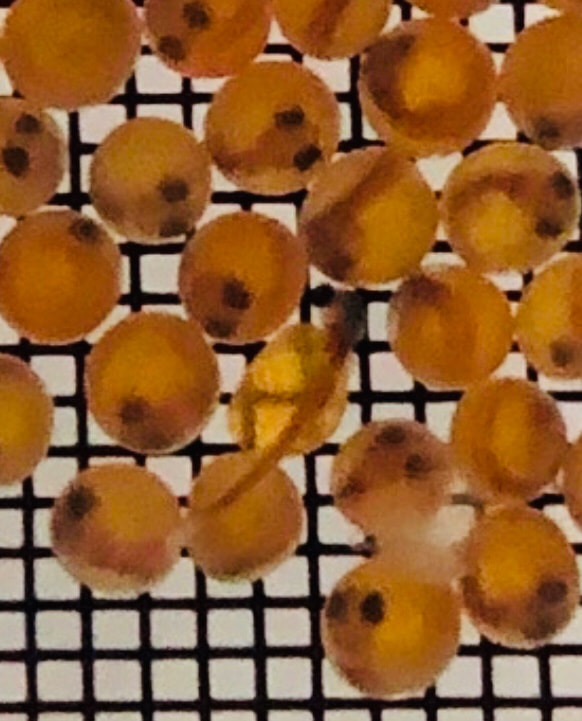 Are "preemies" normal? It depends on what you mean by "normal." In any group of 100 eggs some will hatch early, some will hatch late, and many will hatch at about the time you'd expect them to. It's just like human gestation. On average, women tend to deliver 280 days, or 40 weeks, after conception, but few deliver exactly at that time. The vast majority, however, will deliver in the four weeks that bracket the due date (from two weeks before the due date to two weeks after the due date). But some babies come much earlier than their due date, and a few are more than two weeks late. Here's a chart of human gestation. Perhaps your students can produce a similar column chart of brook trout hatching dates. Look out for mold! A number of schools have reported finding mold on or near their eggs. Here's a photo Sarah Stebbins, of Cold Hollow Career Center, sent to a few of us. Often this is the result of decaying egg shells. Regardless of the cause, it's very important to remove discarded egg shells and anything that looks like mold. Use your turkey baster to do this. Magnified image of embryo Danielle Levine, of Schoolhouse Learning Center, sent me several images of one of their embryos that she took using their "Dino-lite" microscope. Pretty cool! 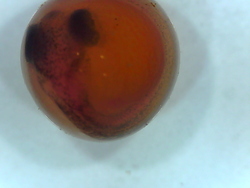 Temperature and swim-up As we've said often, temperature is the principal determinant of how quickly your fish develop. We've also said that in the past we've lost most of our fish during the swim-up stage, presumably because teachers didn't notice that their fish were swimming up and, therefore, needed to be fed (a tiny bit of food). The challenges of noticing the swim-up stage can be greatly complicated by school vacations. So, if at all possible, you want to make sure that your fish don't swim up while you're away from your classroom. We do this by working with the spreadsheet provided on the Managing Swim-up and DI page of this Web site. Using the details that pertained to SWVTTU schools, namely, that when eggs were delivered on 1/8/19, their Cumulative DI was 45.025, I've provided below three scenarios of how you might manage swim-up by regulating temperature. (The details will be slightly different if you got your eggs on a different date. You can use the "NEW 2019 Temp and DI record and swim-up calculator" to perform your own calculations.) SCENARIO #1, Hot and Fast
SCENARIO #3, Vacation ends 3/4
IMPORTANT! In deciding how to manage temperature and the swim-up stage, it's critical that you plan to keep the fry in the breeder basket for 10 days to two weeks after they are all feeding. If you release the fry too early, some are not likely to feed effectively in the "big waters" of the 55-gallon tank. These fry, which get skinnier and skinnier and are called "pinheads," eventually die. An early snow day! Since it looks like quite a few Vermont schools are having a first snow day today and considering that some teachers may have a little extra time to spend on the Internet, I decided to publish the second blog post of the week. Yesterday, eight volunteers delivered 3,000 eggs to 25 Southwestern Vermont TU and five Connecticut River Valley TU schools. Here are some photos from our "egg marathon." (I'm pretty sure additional deliveries were taking place in other regions of the state.) Advice for new trout moms and dads Our little eggs--they are small, aren't they!--are at the most delicate stage of their existence, and they need TLC. Here's some advice for their care during this tender period of development:
Egg delivery in Ludlow Lisa Marks, 4th grade teacher at Ludlow Elementary School, sent these photos of when VTTIC volunteer Kathy Ehlers brought the eggs to LES. Some unplanned "sleepovers" At least two of our new TIC schools weren't quite ready to receive their eggs yesterday. Their tanks were still way to warm. So the volunteer deliverers improvised. They recruited two other area schools to offer to "babysit" their eggs for a few days. I've begun to speak of this as the first sleepover for these little babies. I hope they had a wonderful time! Data, data, data! Experienced TIC teachers probably get sick of me saying this, but it's important that you keep good data records, using two spreadsheets that I've linked to below. Why is this important? Well, for one, regularly using the "NEW 2019 Temp and DI record and swim-up calculator" spreadsheet will almost ensure that you don't miss the swim-up stage, the time frame when, as I said, most schools lose most of their fish. (Once all your fish are "swimming up," you can stop entering data into this file.) The other reason why it's important that teachers keep good records (and share them with our TIC support team near the end of the project) is that we are trying to learn and improve our program every year. There's surprisingly little scientific literature about what we're doing, that is, trying to raise sensitive brook trout in a classroom tank. So I think of our whole statewide TIC team of teachers as a "learning community." Together, by pooling our data and experiences, we can learn more about how to do TIC right every successive year. The spreadsheet you should enter data into now and up to the day you release your fish is this file: "Template for TIC data entry 2019." Many teachers set up a schedule whereby all students, working in small teams, will do water testing for a couple of weeks. But often these teachers also assign the job of recording the data (in the spreadsheet mentioned above) to a couple of the class's more responsible students. What's critical is that the students overseeing the whole water testing process and performing data entry make sure (a) that water testing gets done when it's supposed to and (b) that it's done and recorded accurately. National TIC/SIC Quilt Project! Annually for the past several years, Trout Unlimited's national coordinator of TIC/SIC--these days Tara Granke--has organized a Quilt Project. Many of our Vermont schools have participated and have reported that it was a fun and rewarding learning experience for teachers and students alike. Here are some photos of the wonderful and unique quilts produced by TIC students, mostly in Vermont schools. (As we learned at our TIC workshop this fall, last year Wallingford Elementary School decided to turn their collection of quilt squares into a beautiful book rather than a quilt.) The idea behind the Quilt Project is the following:
Consider signing up! Here are the details from Tara: Dear Educators, Coordinators, and Salmonid enthusiasts: It's that moment you've all been waiting for: it's time to sign up for the S/TIC Quilt Square Exchange Project. This year's theme is Stream Stewards!! Enhance STEAM learning by joining the 2019 Trout Quilt Project. Participating classes create 25 fabric art squares based on your classroom's learning in the S/TIC program. Finished squares and class letters are sent to classrooms across the country! It is a unique opportunity to share your experiences with other classrooms and you get the surprise of receiving quilt squares in the mail. The result—after sewn together—will be a beautiful, colorful quilt! Trout Unlimited staff contact is Tara Granke, [email protected]. To join or for more information visit: https://goo.gl/forms/ik8MKqaGIZBVDyGI3 Eggs and the government shutdown Addison County schools got their eggs yesterday. Bennington, Rutland, and Windham County schools (and perhaps others) should get their eggs tomorrow. That is, depending on the weather, which I think will be okay. Wednesday, however, doesn't look as good! This year for the first time, we're getting our eggs from the federal Eisenhower hatchery in Pittsford, Vermont.  We had a scare when we learned that U.S. Fish and Wildlife Service, which oversees hatcheries, was included in the partial government shutdown. Some of you may have seen the Rutland Herald article that described how the shutdown has affected the hatchery and its operations. Fortunately, hatchery supervisor Henry Bouchard (below) and two of his staff will continue working part-time--but unpaid--to keep their 350,000 fish alive and healthy. So, in spite of the shutdown, I expect to pick up 3,000 brook trout eggs at 8:30 tomorrow morning. Thank you, Henry! What about water temperature? On Monday, the water at the hatchery was 41 degrees. Last week I recommended that you set your chiller to 43 degrees. That should be just fine for now, but more on this topic below. Your eggs will arrive in a covered container. We recommend (VTTIC Manual, Chapter 4, section D.) that you "float" the container, still securely covered, in your tank water for 20 to 30 minutes before pouring the eggs into your breeder basket. This will allow the water in the egg container to come up or down to the temperature of your tank's water. By the way, TAKE PICTURES when your eggs arrive and as you and your students work with them. How many eggs did you get? In virtually every case, schools should expect to get approximately 100 eggs. Hatchery staff typically use the Von Bayer method, which involves lining eggs up side-by-side in a foot-long V-trough. This approach, however, assumes that all the eggs are of exactly the same diameter. Undoubtedly they're not. So you might have gotten 100 eggs or 122 or 81. You won't know until you count them--or have your students do so. Some teachers challenge their students, perhaps by working in teams, to come up with an effective method for performing an accurate count. One method some teachers use is to photograph the eggs once they're spread out in a single layer on the bottom of the breeder basket. Then they either project the photo on the classroom's screen or print a few copies of the image and give them to the student teams. Let us know what your students decide to do. If you teach older students and if some of them are very technologically minded, you might share this article with them and challenge them to replicate the methodology in this article. Water temperature and trout development The rate at which your eggs will hatch and, in general, the rate at which your trout will develop is directly related to water temperature. In the early stages of development, we use Development Index (DI) to quantify and keep track of development. Here's a table that provides the DI constant that is added to Cumulative DI for every day that the water is at a certain temperature. In this table, which is also on page 81 of the Manual, you can see that, e.g., at a temperature of 43.5 F, you will be adding a DI value of 0.720 to whatever the Cumulative Development Index had been on the previous day. By contrast, if your tank temperature was 52.1 F, you'd be adding a DI constant of 1.411 to the cumulative DI.
N.B.: This table was developed for Atlantic salmon and isn't completely accurate for brook trout, which develop more quickly than do Atlantic salmon. So, where the chart suggests that 90% of your eggs will be hatched when the Cumulative DI hits 58%, they will almost certainly all be hatched before your Cumulative DI gets to that point. Similarly, our experience has taught us that brook trout will hatch well before Cumulative DI hits 100. DI, "swim-up," and school vacations So, why do we care about DI? Most schools lose most of their fish during the swim-up stage, either because the teachers didn't know what the swim-up stage looked like or because the swim-up stage occurred while the teacher was away from the classroom. For that reason, I've created several Web pages, available through this site, to help teachers understand, plan for, and schedule swim-up. You'll find access to them here. This is important stuff. Please take time to review these pages. Most teachers will want to have their alevin swim-up after the winter break. Those teachers can keep their tanks at 43 degrees F for a while. But those who want to use what we call the "Hot and Fast" approach to get their fish feeding before winter break will want to raise the tank temperature to 55 degrees F as quickly as they can while not raising it more than three degrees in any one day. |
Joe Mark is Lead Facilitator of Vermont's Trout in the Classroom program.In June 2012, I retired after 40 years in higher education, having spent the last 32 years of my career as dean at Castleton. One of the first things I volunteered to do in retirement was to work with a parent-friend to help the Dorset School, where his kids and my Vermont grandkids attend, start a TIC program. Gradually that commitment grew into my current role, which is both demanding and highly rewarding. Archives
December 2019
Categories |
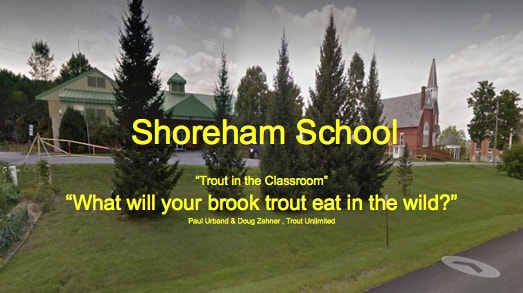
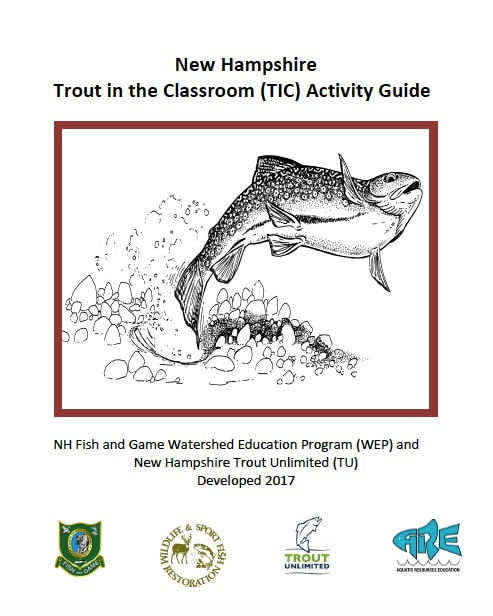
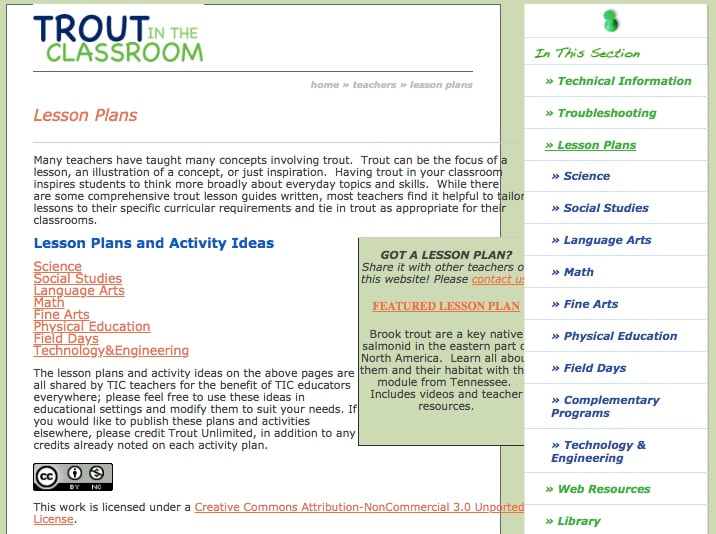
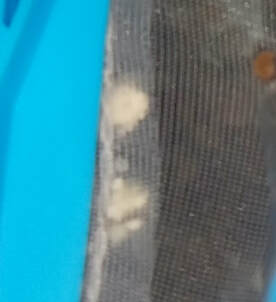
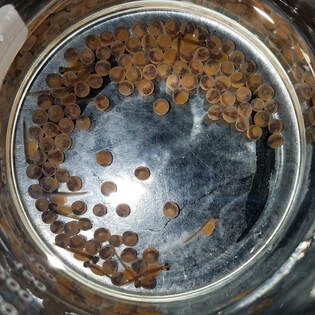
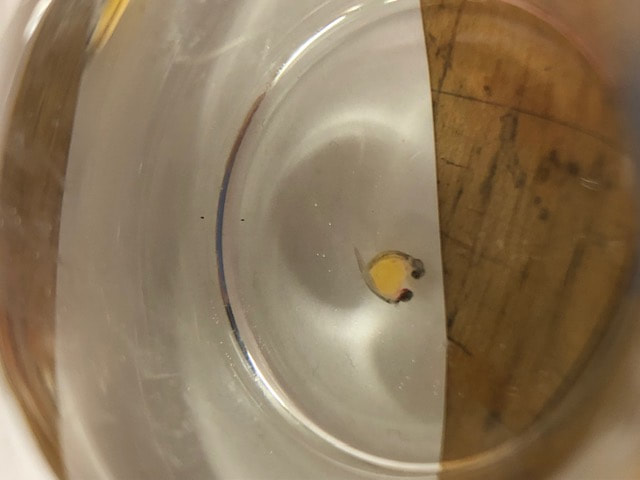
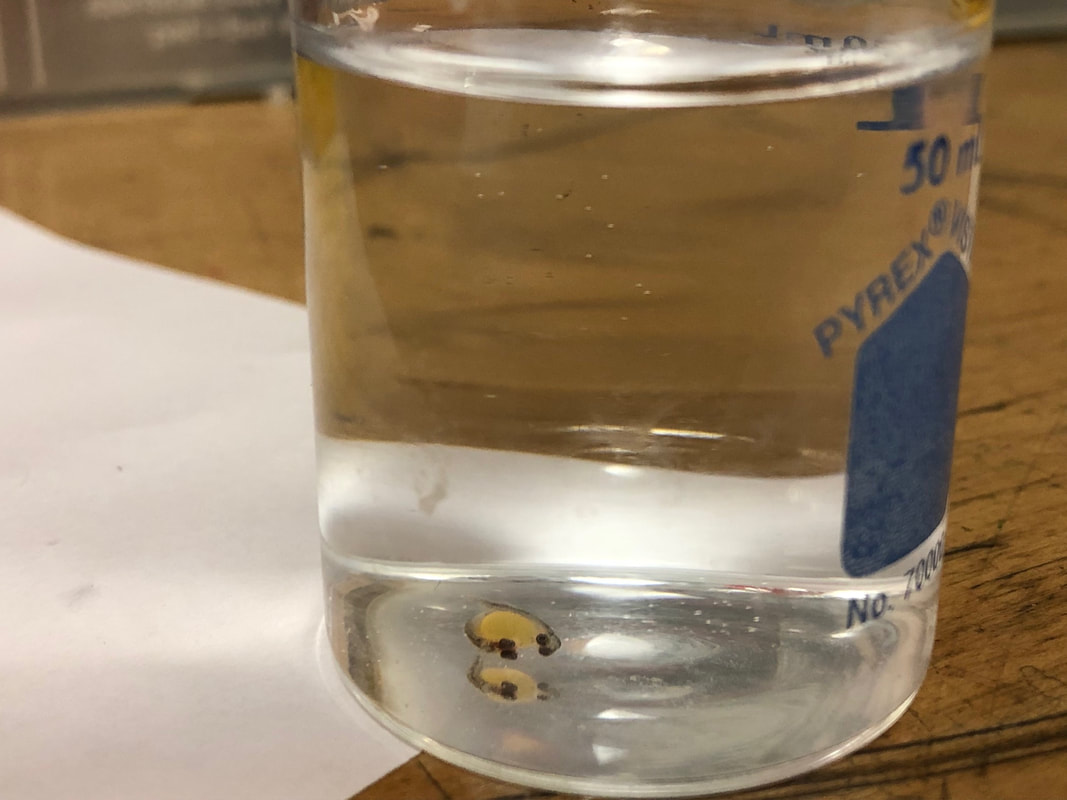
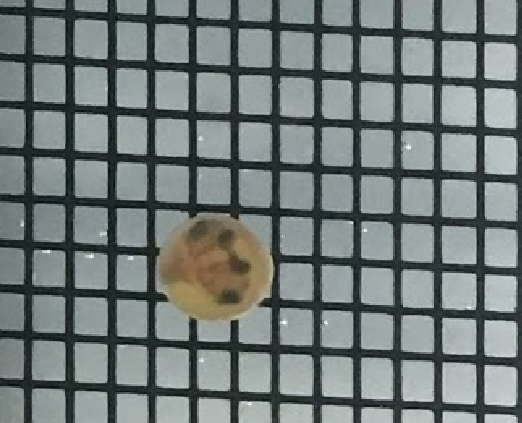

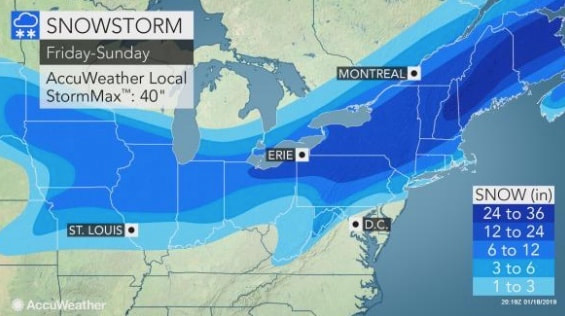

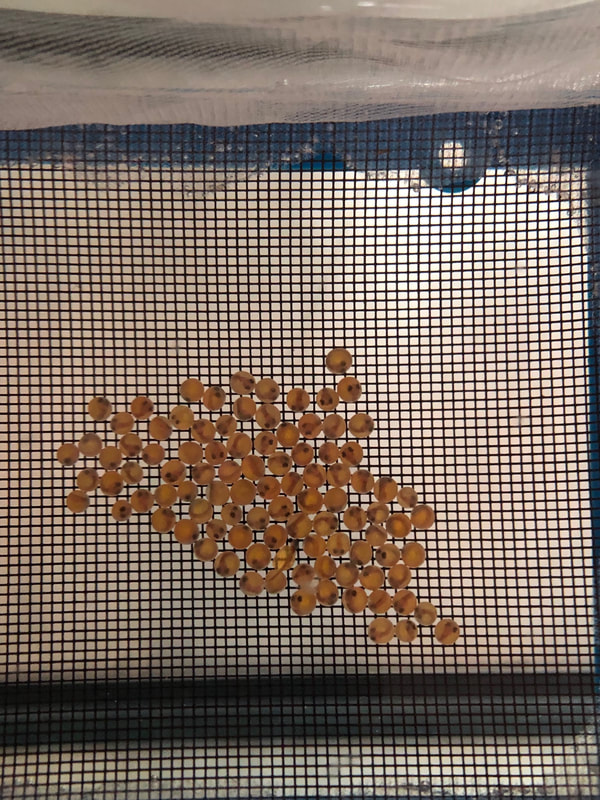
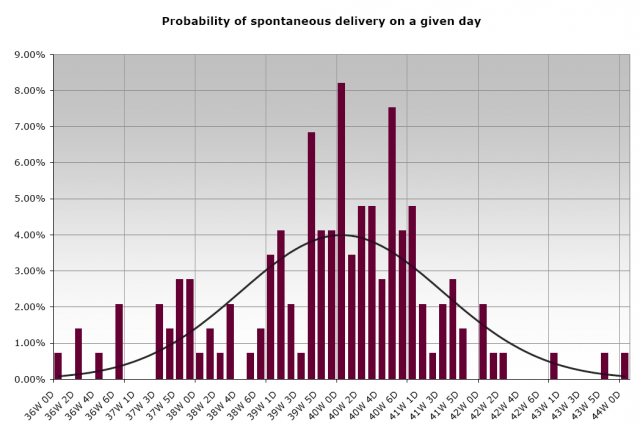


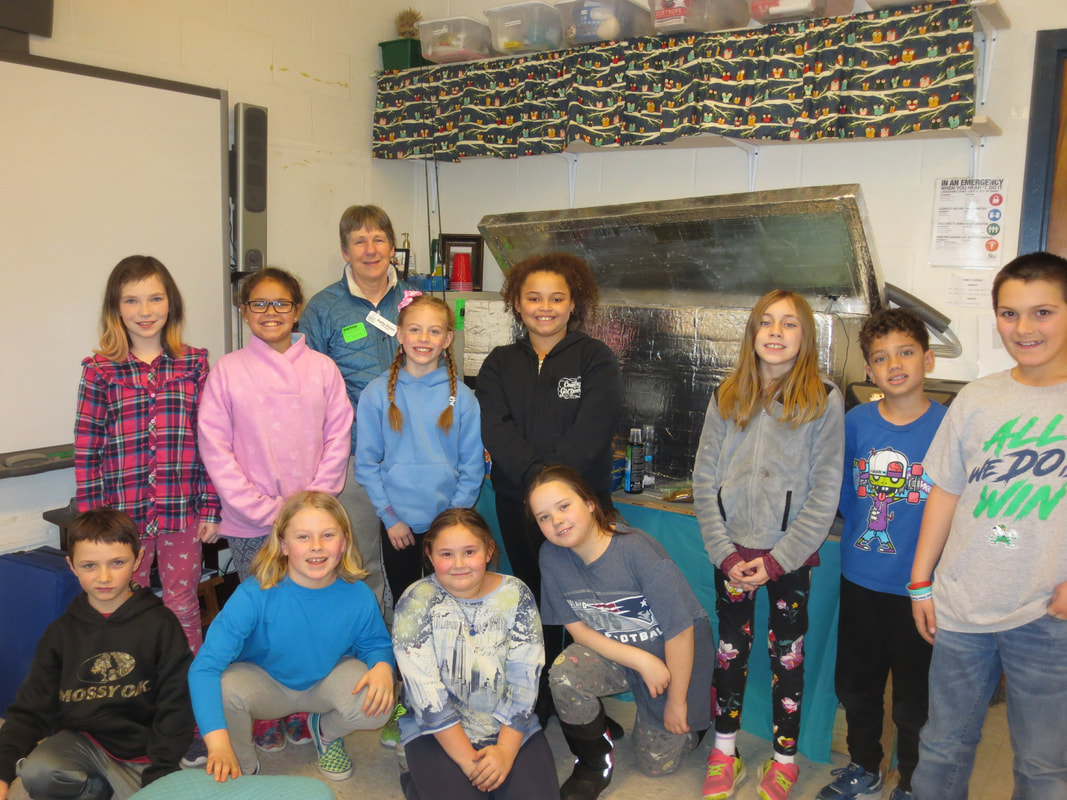


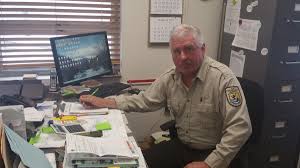

 RSS Feed
RSS Feed
